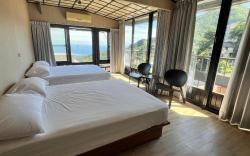Zhuang Gongsheng's Historic House Introduction
Zhuang Tingcan, whose ancestral hometown is Guijiao Township, Nanjiang, Zhangzhou, Fujian, had his great-grandfather Zhuang Chaoxin move to Taiwan in 1756. Zhuang's father, Zhuang Yuanzhu, relocated to Shuangxi in 1851 (the first year of the Xianfeng era), continuing a family tradition of farming and education. Zhuang Tingcan became a scholar in 1877 (the third year of the Guangxu era) and was granted a stipend in 1888 (the fourteenth year of the Guangxu era). In 1895 (the year of Yiwai), he returned to Zhangzhou to avoid the Japanese army, and in 1901 (the twenty-seventh year of the Guangxu era), he took the provincial exam in Zhangzhou and later returned to Shuangxi to enjoy his old age. After becoming a scholar, Zhuang Tingcan established a private school called "Meizhu Garden" near his ancestral home, focusing on Confucian teachings and nurturing talented individuals. During the Japanese occupation, locals referred to him as an elder from the Qing dynasty. His elder brother, Jinbo, also gained recognition, and the brothers earned great respect, leading to a close connection between the "Zhuang Gongsheng" family and the local history, traditional Confucianism, and cultural development. This century-old ancestral house showcases traditional Minnan-style architecture and is one of the few ancient houses still in use in the Shuangxi District. The overall structure of the house remains largely unchanged, and even the interior walls have not undergone modern decoration, showcasing its original stonework. Although the exterior of the ancient house has weathered the years, the intricate carvings remain clear, particularly the reliefs of camellias on the left wing, symbolizing prosperity, which are well-preserved and worth seeing. The Zhuang Yesheng Ancient House is located opposite the Camellia Zhuang Educational Farm.







































